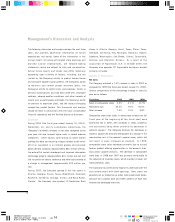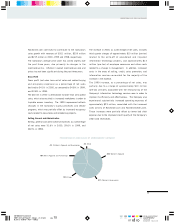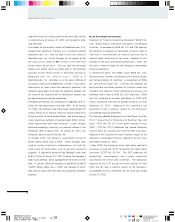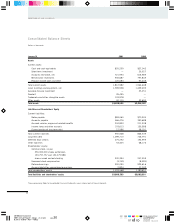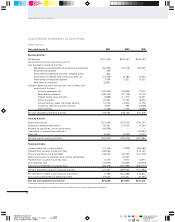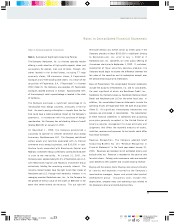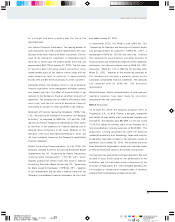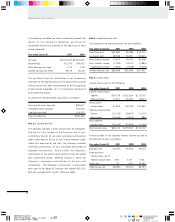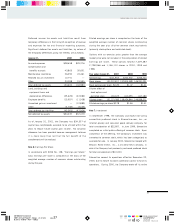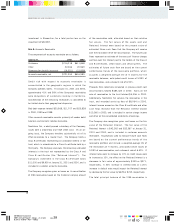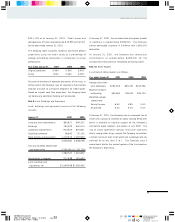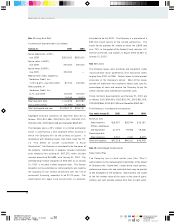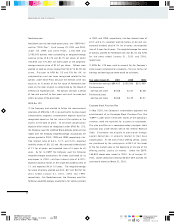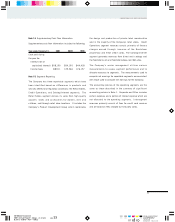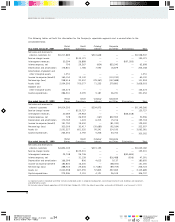Nordstrom 2000 Annual Report Download - page 26
Download and view the complete annual report
Please find page 26 of the 2000 Nordstrom annual report below. You can navigate through the pages in the report by either clicking on the pages listed below, or by using the keyword search tool below to find specific information within the annual report.
Cyan Mag Yelo Blk
20100444 Nordstrom
2001 Annual Report • 44pgs. + 4 covers pg. 24 PMS
5773
PMS
5503
24
NORDSTROM, INC. AND SUBSIDIARIES
Shipping and Handling Costs: The Company’s shipping and
handling costs include payments to third-party shippers and
costs incurred to store, move and prepare merchandise for
shipment. The costs are included in selling, general and
administrative expenses.
Advertising: Costs for newspaper, television, radio and other
media are generally expensed as incurred. Direct response
advertising costs, consisting primarily of catalog book
production and printing costs, are capitalized and amortized
over the expected life of the catalog, not to exceed six
months. Net capitalized direct response advertising costs
were $5,697 and $3,938 at January 31, 2001 and 2000,
and are included in prepaid income taxes and other on the
consolidated balance sheets. Total advertising expenses were
$190,991, $160,957 and $145,841 in 2000, 1999 and
1998.
Store Preopening Costs: Store opening and preopening costs
are charged to expense when incurred.
Cash Equivalents: The Company considers all short-term
investments with a maturity at date of purchase of three
months or less to be cash equivalents.
Cash Management: The Company’s cash management system
provides for the reimbursement of all major bank
disbursement accounts on a daily basis. Accounts payable at
January 31, 2000 includes $7,605 of checks not yet
presented for payment drawn in excess of cash balances.
Investments: Short-term and available-for-sale investments
consist of available-for-sale equity securities which are
recorded at market value based on quoted market prices
using the specific identification method. Unrealized gains
and losses from changes in market value are reflected in
accumulated other comprehensive earnings, net of related
deferred taxes. Realized gains and losses and declines in
value of the investments judged to be other than temporary,
are included in net earnings.
Customer Accounts Receivable: In accordance with industry
practices, installments maturing in more than one year or
deferred payment accounts receivable are included in
current assets.
Merchandise Inventories: Merchandise inventories are stated
at the lower of cost (first-in, first-out basis) or market, using
the retail method.
Land, Buildings and Equipment: For buildings and
equipment acquired prior to February 1, 1999, depreciation
is computed using a combination of accelerated and straight-
line methods. The straight-line method was adopted for all
property placed into service after February 1, 1999 in order
to better reflect the utilization of the assets over time. The
effect of this change on net earnings for 1999 was not
material. Lives used for calculating depreciation and
amortization rates for the principal asset classifications are
as follows: buildings, 5 to 40 years; store fixtures and
equipment, 3 to 15 years; leasehold improvements, life of
lease or applicable shorter period; software, 3 to 7 years.
Capitalization of Interest: The interest-carrying costs of
capital assets under development or construction are
capitalized based on the Company’s weighted average
borrowing rate.
Intangible Assets: Goodwill, trademarks and other intangible
assets are being amortized over their estimated useful lives
on a straight-line basis ranging from 10 to 35 years.
Accumulated amortization of goodwill was $429 and of
trademarks and other intangible assets was $822 at January
31, 2001.
Asset Impairment: The Company reviews its intangibles and
other long-lived assets annually to determine potential
impairment. The Company estimates the undiscounted
future cash flows expected to result from the use of the asset
and its eventual disposition. If the sum of the expected
future cash flows is less than the carrying amount of the
asset, an impairment charge would be recognized.
Deferred Lease Credits: Deferred lease credits are amortized


